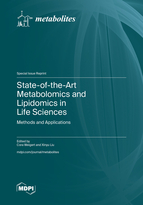State-of-the-Art Metabolomics and Lipidomics in Life Sciences: Methods and Applications
A special issue of Metabolites (ISSN 2218-1989). This special issue belongs to the section "Lipid Metabolism".
Deadline for manuscript submissions: closed (15 August 2023) | Viewed by 19231
Special Issue Editors
Interests: exercise metabolism; skeletal muscle; liver; insulin resistance; mitochondrial respiration; myometabokines
Special Issue Information
Dear Colleagues,
The understanding of mechanisms in disease development and treatment has been the center of life science research for decades or even centuries. Over the past twenty years, substantial progress has been made by the establishment regarding the application of metabolomics and lipidomics approaches, which has allowed researchers, for the first time, to study a plethora of metabolites and metabolic pathways simultaneously.
From microbes to plants, to animals, to humans—all kinds of samples have been investigated by these techniques, thereby making a considerable contribution to the increase in knowledge in all facets of life sciences. Additionally, novel analytical methods and strategies, along with new bioinformatic tools for the evaluation of these very complex metabolomics, lipidomics or multi-omics data, have been developed.
Profs. Guowang Xu and Rainer Lehmann have been closely cooperating for 25 years in this field of research. In 2023 Metabolites is pleased to announce this Special Issue dedicated to Profs. Guowang Xu and Rainer Lehmann about state-of-the-art metabolomics and lipidomics research in life science to celebrate this fruitful Sino-German scientific cooperation and their close friendship.
This Special Issue welcomes, especially from colleagues and friends, the submission of high-quality reviews, original research articles or other types of papers addressing all aspects of life science research from microbes, plants, animals to humans applying metabolomics or lipidomics, as well as reports on new biomarkers, protocols, strategies or bioinformatic tools.
Prof. Dr. Cora Weigert
Dr. Xinyu Liu
Guest Editors
Manuscript Submission Information
Manuscripts should be submitted online at www.mdpi.com by registering and logging in to this website. Once you are registered, click here to go to the submission form. Manuscripts can be submitted until the deadline. All submissions that pass pre-check are peer-reviewed. Accepted papers will be published continuously in the journal (as soon as accepted) and will be listed together on the special issue website. Research articles, review articles as well as short communications are invited. For planned papers, a title and short abstract (about 100 words) can be sent to the Editorial Office for announcement on this website.
Submitted manuscripts should not have been published previously, nor be under consideration for publication elsewhere (except conference proceedings papers). All manuscripts are thoroughly refereed through a single-blind peer-review process. A guide for authors and other relevant information for submission of manuscripts is available on the Instructions for Authors page. Metabolites is an international peer-reviewed open access monthly journal published by MDPI.
Please visit the Instructions for Authors page before submitting a manuscript. The Article Processing Charge (APC) for publication in this open access journal is 2700 CHF (Swiss Francs). Submitted papers should be well formatted and use good English. Authors may use MDPI's English editing service prior to publication or during author revisions.
Keywords
- metabolomics
- lipidomics
- life science
- biomedical
- human
- blood
- urine
- cell culture
- tissue
- microbiome
- plants








